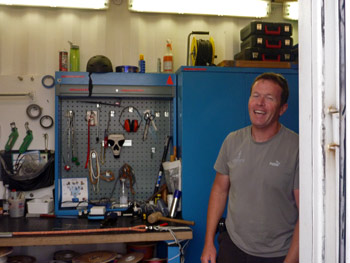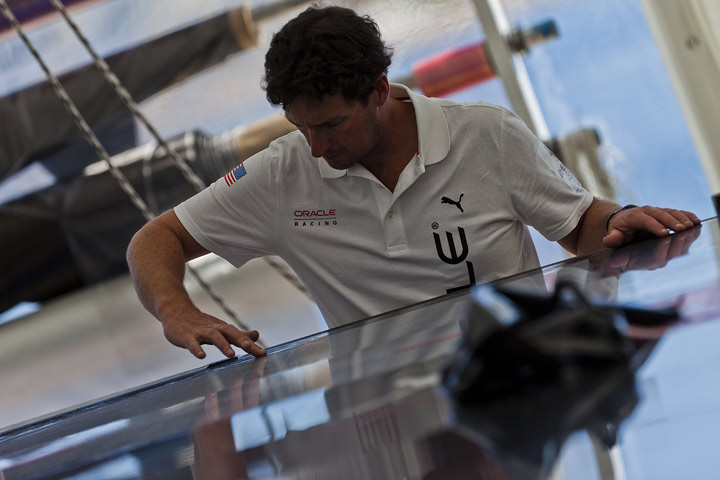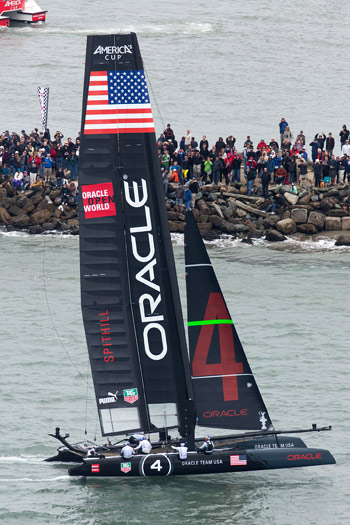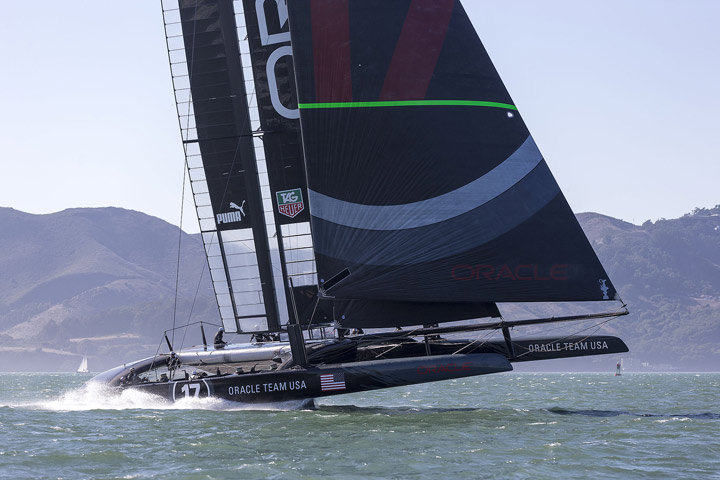|
|
||||||||||||||||
|
Oracle Shore Crew: Talk with Andrew Henderson October 5, 2012 |
||||||||||||||||
|
“I’ll tell you right now, we’ve got the best shore team. There’s no question in my mind. They’re the first guys down there and the last guys to leave. They really put everything into it and it really allows us to just concentrate on the racing.” That’s how skipper Jimmy Spithill describes his Oracle Racing shore team – the ten guys behind the scenes who make sure his AC45 stays in top shape, no matter how hard the day’s racing. One of the primary cogs in the Oracle Team USA wheel is Australian Andrew Henderson, the head of rigging and part of the reserve crew. “Hendo” has been with Oracle since just before the catamaran-versus-trimaran America’s Cup showdown in February 2010, bringing an extensive ocean racing background to the program, including his experience in 15 Sydney-Hobart races. He takes us on a tour of the Oracle Team USA compound, talks about the mountain of work involved in dealing with two AC45 catamarans during the America’s Cup World Series events -- and how one little mistake on the race course can ruin the evening for the shore crew. The ACWS is a road show, but instead of touring the country they cross the globe, with America’s Cup Regatta Management (ACRM) taking the show from Europe to America and back again multiple times. “Everything we have packs into the four shipping containers that make up the compound,” explained Henderson. Arrival in a new venue follows a practiced sequence. “First ACRM places the containers, then we put up the tent -- we have to wait to unload the wing until the tent is set up, because any wind across the wing could be catastrophic. “We get here on a Monday morning at 9 am, and by 3 pm this whole thing is up and ready to go. From putting the containers on the ground until we’re ready to go sailing is three or four days.” “The more you do it, the less daunting it becomes. The guys who made the rule understood how long it would take -- they asked us, Artemis, Team New Zealand. We all gave an opinion, so there was a consensus as to the timing.” Once empty of the main components of the disassembled AC45’s, the Oracle Racing containers then become the workshops for the different departments.
“One container is for sail storage -- all the racks fold up when not in use. The sails sometimes get stored inside the wings for transport, otherwise one wing goes into the rack in two parts and the sails go on the side. One 40-foot container can hold the whole wing and all its associated parts, which is quite a few boxes. It’s amazing how much we can fit into such a small space. Another container is for boat building -- anything that has to do with the building or repairing of the boats is done in one container. And we have our rigging container, where we have a test bed so we can test all the strops that go on the boat. They are pulled to the load they’ll see before they go on, so that we know that any given part can deal with the load. “The wing elements have their own stand, or splash, that they go into. They go into the splashes and get anchored to the floor of the container. It all happens pretty quickly, since everywhere they go is marked. Once they’re in the splashes, they’re pretty secure, with all the straps. All the shore team guys are designated into teams and we work pretty efficiently. “Because we’ve been sailing these boats more than anyone, the set-up and the pack-up -- the details of how we put everything together -- is pretty well straight on.” While the sailors and designers love having two boats to learn on, for the shore crew it means twice as much work -- and then some. Because Oracle Team USA adopted a two-boat program ahead of everyone else, plus a San Francisco-based training program, they quickly built up a lot of experience with lifting and dropping the boats in and out of the water, along with the pre-sail preparation and post-race care needed maintain an exotic multihull racing yacht. They estimate that even in the first six months they had probably done about 1000 lifts and drops. That much repeated motion naturally inspired efforts to streamline the process, save time and effort for the crew, and minimize risk of damage to the boats. And having multiple boats on the water naturally bred some internal competition, too. “The development sort of chases each other, so we’re always catching up with that -- one boat has one thing and the other boat wants to do it," Henderson said. "But it’s good, because our boats are quite obviously fast. The guys have done nice work, we just need to point them in the right direction! “We do a thousand little things to make the boats perfect -- after a round, we bring them inside, put leaf blowers inside the, we dehumidify the wings to take ounces of weight off of them. We do all the really small things -- then the guys miss one tack or a gybe or get a wrong wind shift and all that work means nothing. It can be a little bit frustrating, but it’s all part of the game. That’s why we enjoy being the shore team, because the joy for us is in those little small things, in tinkering with the little things.
“The wing frames are super lightweight; they’re made with honeycomb on Nomex. They have a tendency to suck up water – so if you tip them over, they’ll absorb water quite quickly. And it weighs nothing, you can twist it or break it or snap it over your knee. On its own, it’s a very fragile piece of equipment, but all together, it provides the frame for the film we put on, so we really look after it. “So when they guys sail, if they’re tight in a race and forget to let off a line, the wing will come across and hit the line and break all the frames along the edge. So we have to cut holes in the Clysar film, clamp it and repair it. There’s a lot that goes on after a small mistake on the water -- it makes a big job list in here.” Not that Henderson is complaining -- the shore crew is equally as proud of the sailing team as the sailing team is of the team that gets them out onto the water every day. “We have extreme confidence in our sailing team. They’re really good guys and they’ve brought home some really good results. So the effort is worthwhile. And they’re very appreciative of our work so that makes the job easy.” Admittedly, as a one-design class, innovation with the AC45 is limited by the rules. Much of the cat‘s technology is pre-determined -- but teams are finding ways to improve the product by tweaking rigging, soft sails, the bowsprit, and the furling systems. Among the myriad of new terms introduced to the America’s Cup lexicon this cycle is Clysar, the film used to cover the hard wing. Clysar is not the ubiquitous, stretchy shrink wrap material that surrounds shipping loads or bulk products; instead, it is a flexible packaging film that seals in products via a shrink tunnel, specially engineered for strength and clarity. All the teams had to learn how to deal with this new material. “The big issue we have with the transportation of the wing is the temperature variation, from where we start to where we end up, and how it fluctuates in between. Once you close one of these containers up and it gets hot in there, we have issues with shrinkage of the Clysar film that covers the wings. Often we get to an event, with a tight set up time, and we’ve got a new Clysar job to do, because it split or pulled away – sometimes, we’ve even had the adhesive on the tape melt, it gets so hot in the container. “ Oracle added another variable into the equation
coloring their Clysar black, giving Henderson and the rest of the
shore team another large problem to stay on top of.
Black objects absorb a wider spectrum of sunlight than clear film or other colors, transferring heat, which means that the shore team has to keep an eye out during the regattas since even a bright sunny day can be problematic for the delicate film. “On a day with little wind and with the sun directly on the wing, we can have an issue with it shrinking and breaking in spots. So while it’s a terrific marketing tool, logistically it’s a nightmare! “The black just attracts so much more temperature. When you set the wing up, you put double-sided tape along all the frames and along the trailing edge and then you apply the Clysar across it. You stick the film across the double-sided tape to apply it, trim off the edges then use a heat gun to shrink it up. Then you iron the whole thing. We’ve had to do more taping than any of the other teams -- one wing takes two guys about two days. So if you’ve had an issue, that’s four days gone for two guys. So it can be a bit of an interruption to our setting up process! “But we’ve had to make patches every regatta, so we’re getting good at dealing with it. And it doesn’t seem as though the other teams have had this issue at all! So while marketing’s important, is it important enough to cost you races -- I suppose that’s the question. But we’re dealing with it. In Cascais, we hosed down the wings (to keep them cool). We’d leave them in the shed for as long as possible and bring them out half an hour before the race.
One of the primary areas of innovation for the teams has been the soft sails -- the inventory of gennakers and genoas that compliment the hard wing. “We feel we’re pretty strong downwind,” said Henderson. “The boys have done a lot of work with the gennaker, with the size and shape. There is some good footage of Jimmy and the guys deeper and with a lower angle, but with the same speed as the other guys. A lot of that is technique -- steering and how they sail the boat -- but the gennaker doesn’t hurt!” Henderson admits that the team probably has a bit of an edge with the catamarans, given their experience with the 90-footer in AC33. But a surprisingly small percentage of information translated directly from USA 17 to the AC45’s. “I’d say we brought maybe 15% of the stuff we learned from the 90-footer to these boats. The knowledge base is out there and it’s easy to find out about this stuff, but the familiarity with it and being with a design or a concept -- it all rings a little more true since we worked on the 90-footer with the big wing. So we’re ready to take the next step and develop it further, rather than having to come to grips with a new concept. Most of the other teams are working with a new concept – the wing with the way it cambers and twists -- whereas our guys have already done it, so the concept is familiar. So straightaway we’re into developing it or tweaking other areas. So we can invest our time better because we already have a grasp of the key concept.” The stakes are going exponentially higher with the new AC72’s. Oracle launched their first catamaran at the end of August, and to date has sailed it for four of the allotted 30 days permitted before the end of next January. The development process for the 72-footer places an even higher set of demands on the team. “A new class in itself is intimidating because there are a whole lot of bad traps that you might not have seen before. And the design team is always trying to push the limits -- we’ve tried to get fittings smaller, lashings smaller, rigging smaller. With everything you do, there’s a weight cost, especially with these boats. So it meant a new round of testing -- and none of what we learned about the 90-footer is really relevant once we go to the AC72. We’ll need to be on top of our testing for every specific component, because each component should be just strong enough and last just long enough to do the job. It should be ‘just there,’ with a big enough safety factor in case there’s a strange load case, it survives. Everything is going to be right on the edge once again for this new class -- there will be some action." “But I think the 45 has been good -- we’ve done a lot of testing with different configurations that hopefully will scale up to the 72. And we’ve got a pretty talented design team that are very inclusive of guys like myself, who actually operate on the ground, in regards to what we’re seeing with the 45 and making sure it gels with the 72," says Henderson. Getting a 72-foot wingsail catamaran ready to not just hotdog around the bay, but making it both bulletproof enough and fast enough to face a challenger when the America's Cup is on the line is the ultimate goal. Incidents during testing, like losing a daggerboard during the shakedown cruise though unwelcome aren't unexpected, and are indeed why the teams test so hard, but racing to defend or challenge for the Cup is an utterly unforgiving task. "I think we’re fairly confident it will be a
good product, but there will be a hell of a lot of hours between
now and then -- not only in testing, design, and development, but
just in getting the boat out there and thrashing around, making
sure it’s a reliable product. The America’s Cup is only a
few races and a whole lot of time prior to make sure everything’s
perfect. We’re a very well-funded team, so we have no
excuses at all. There’s no excuse for any sort of failure,
be it rigging, sails, we should have every base covered.
That’s why we’re working so hard now, to put on a good show and
to not have any failures. It’s going to need to be the same
in the AC72.”
Links of Interest: |





